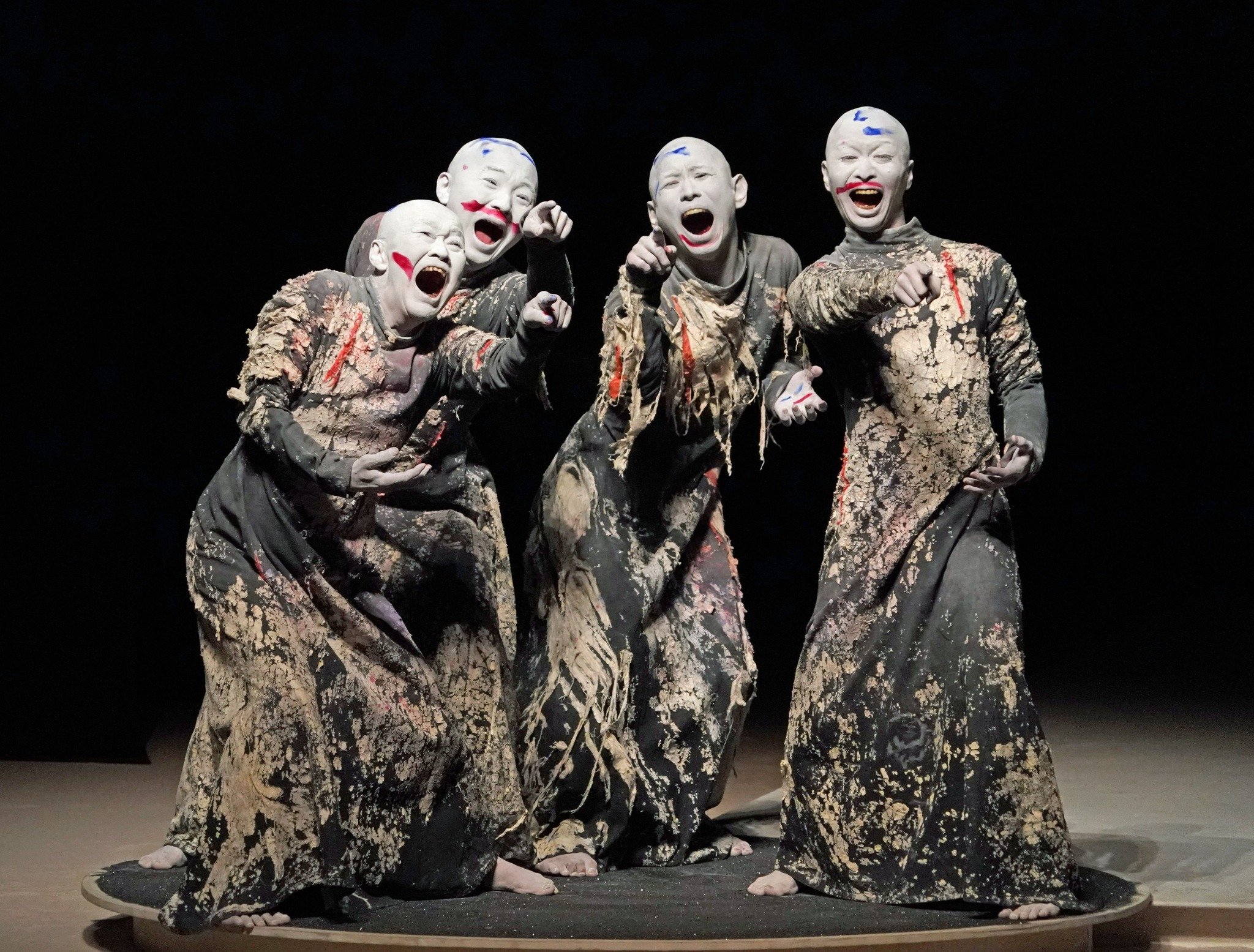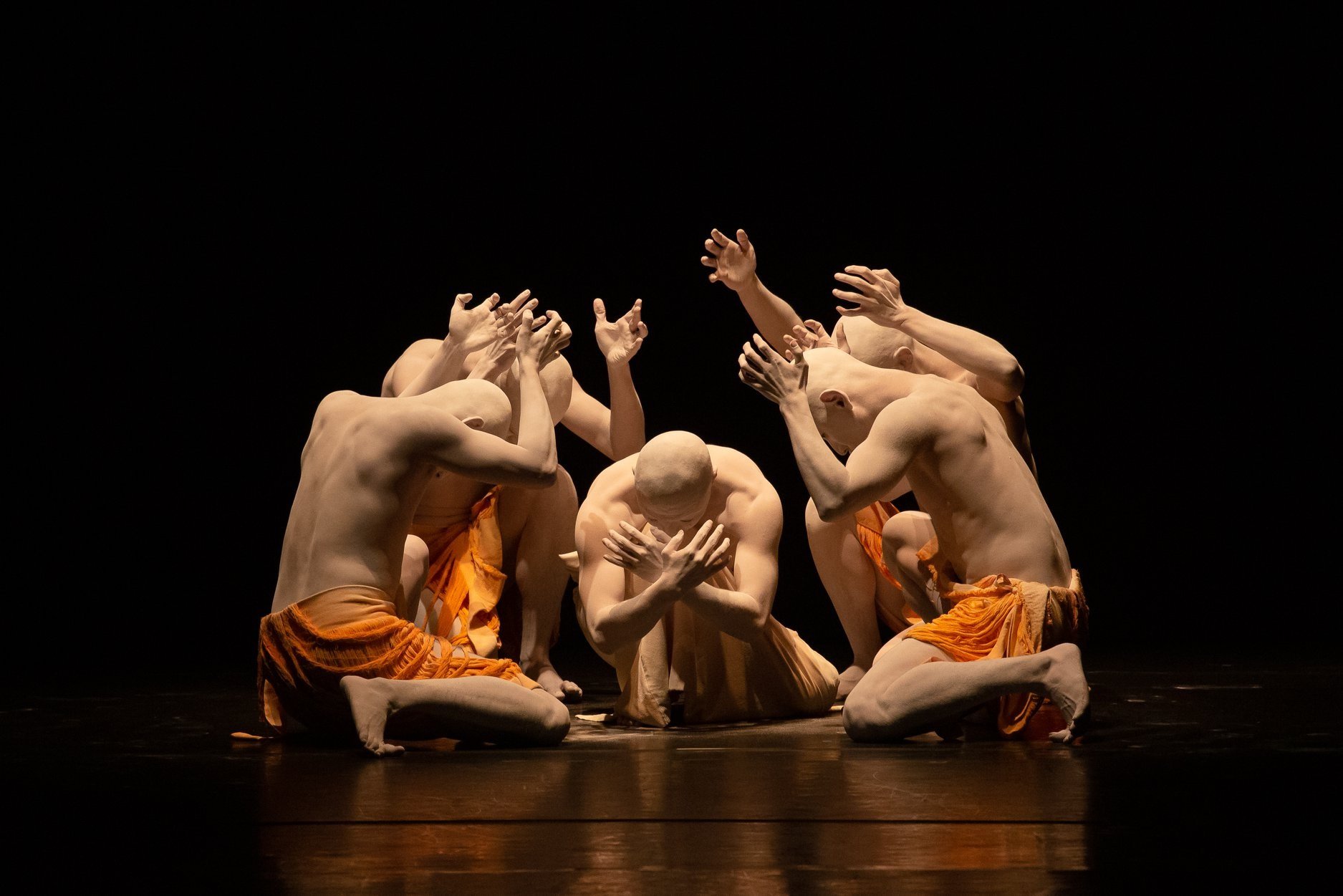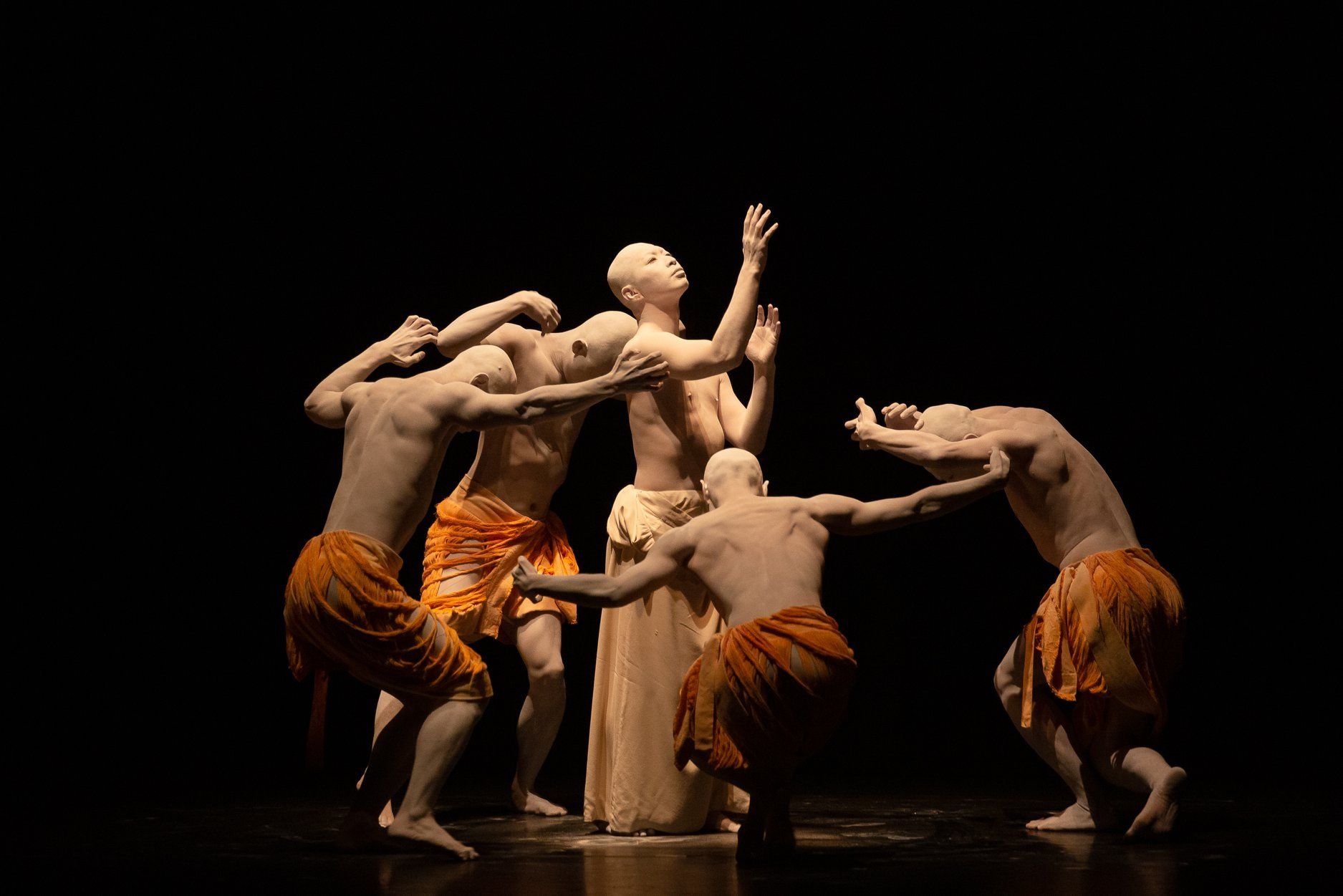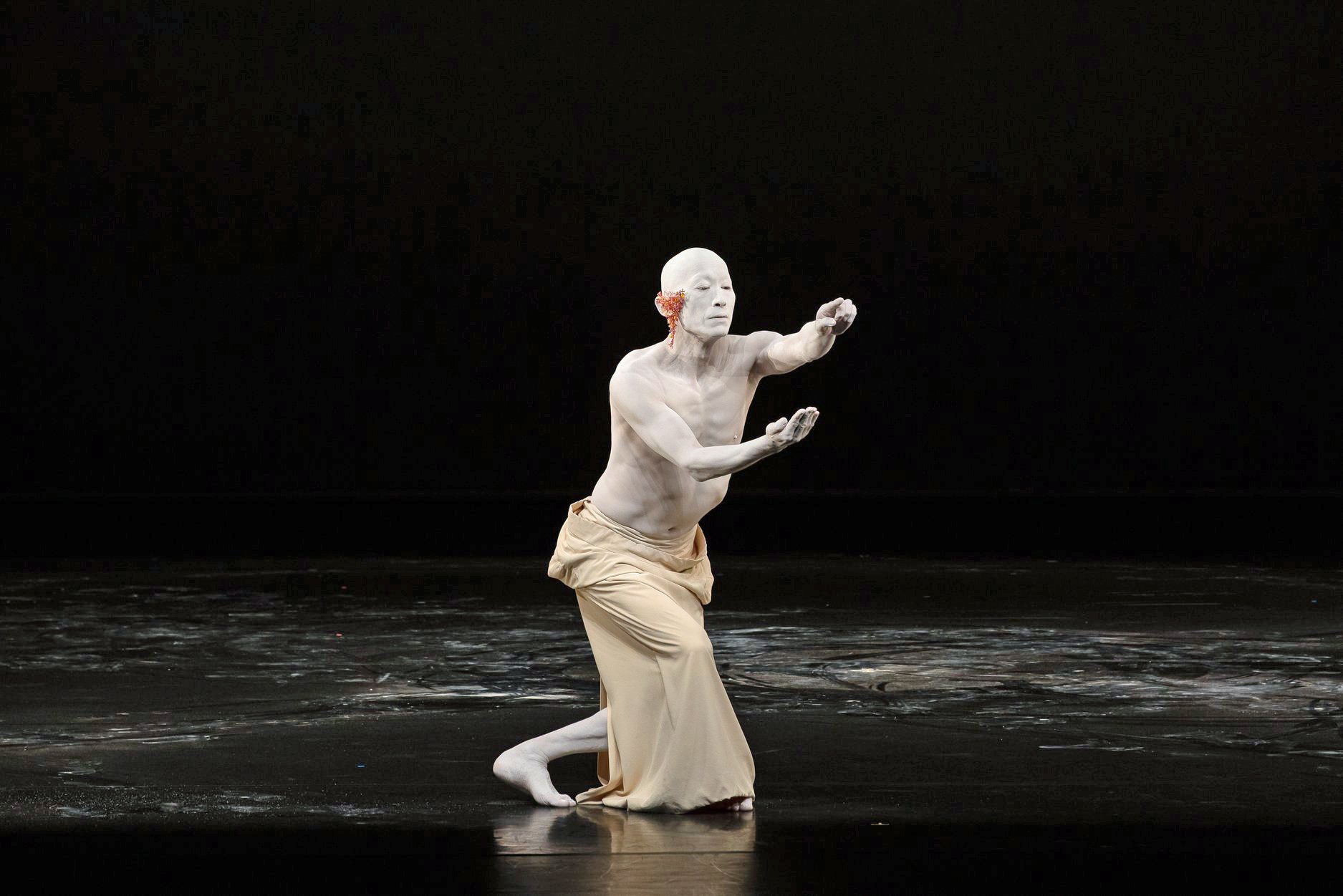Sankai Juku: ‘KŌSA - Between Two Mirrors’ @ TITAS/Dance Unbound
—Teresa Marrero
On October 13th and 14th, Dallas audiences had the privilege of experiencing an anomaly in dance: a study in minimalist stillness. Sankai Juku (which means “sea and mountain lodgings”—elements integral to Japan’s landscape) is an all-male dance company founded in 1975 and still directed by founder Ushio Amagatsu, who also functions as choreographer, designer, and dancer. It is a second generation butoh dance ensemble. Butoh, which means “dance step,” developed from the work of Tatsumi Hijikata and Kazuo Ôno in the late 1950s.
It is considered an avant-garde art form even in Japan, due to its deviation from more traditional Japanese movement forms such as kabuki and noh. Some of its integral characteristics are that company members are men, they appear onstage with chalky white shaved heads and body paint, wear either long skirts or long gowns (costumes by Masayo Iizuka) in neutral colors, and execute extremely slow, deliberate movements.
When the lights went down at the Moody Performance Hall just prior to the beginning of the performance there was a sense of expectation. This was soon followed by nervous coughs and fidgeting during what seemed to be an interminable waiting period. It struck me as a particularly Western attitude of resistance to stillness and quietude. It also seemed an intentional move to settle the audience into a meditative state of mind.
With a stage devoid of any sort of artifacts, the dancers moved onto the stage as if walking on air. The subtle lighting was enough to illuminate but not obtrude. The music by YAS-KAZ and Yoichiro Yoshikawa, seemed to use the traditional Japanese koto, also known as the Japanese harp. It’s defined as “a stringed instrument with a rich and detailed history…consists of 13 strings that are strung over 13 bridges. There is actually one type of koto that has 20 strings.”
The complexity of the music in the 80-minute work varied among the different dance sections. Some had delicate bells and others driving synthesizers or something that sounded like a water drum. At times the piano made an appearance. What became clear was the congruity of relations between the soundscapes and the dancers, among the dancers, and within each dancer.
What do I mean by this?
Bear with me because this fluid performance is a meditation, a visual feast, and an exercise in restraint. In Western dances, the relationship between the music and the dancer/choreography is usually correlative and relational. One expects certain types of moves if the music extends in time, or if it contracts, or if it hits highs. The body of the dancer responds to or anticipates the music. In this case, the music seemed to be its own entity, and the dancers their own entities as well. This is not to imply that the dancers never reacted to the music. They did, but only occasionally and to make a particular emotional point.
The dancers seemed to appear in groups of four dressed alike, and sometimes with a fifth dressed differently. There were solos and group numbers, each conveying a different image/feeling that ranged from abstraction, to deep despair, to prayer, to hopefulness.
To a Western audience, some of the more unusual moves approached the grotesque, with the intentional use of wide-open mouths that looked bizarre framed by white chalky faces. The stillness of the moves originated mostly from the waist up, with minimal employment of the legs. Let us pause here for a second. The dancers’ legs were barely visible, hidden by the long gowns, except for their bare feet upon the stage. However, one got the sense that the legs here served to anchor the body firmly onto the ground, working with rather than defying gravity.
The arms seemed to extend for miles apart, often giving the impression of wings. The fingers constantly articulated and conveyed meaning, but not in a literal way. The movements seemed to hinge from the body’s gravitational center, the chi energy around the belly. There were lots of moves bent over looking down onto the ground—and conversely, other pieces performed completely erect with the head looking up (the entire time!).
The dancers’ bodies also appeared synchronized in some mysterious way. Sometimes they moved in unison, others independently or sequentially. I had the impression that here again there was a coupling or harnessing of dissident or opposing forces. The dancers glided flat-footed on the floor, feet never leaving the ground.
There were times when silence prevailed and the bodies of the dancers maintained a sculptured stillness that—while it looked easy because they weren’t “doing anything”—must have required a sizable investment of contained energy.
While the stage design (Amagatsu), the lighting (Genta Iwamura) followed a meditative color scheme, there was one moment in which a shocking apple green upstage lighting provided the two dancers a shadow dance-like presence.
How does a piece like this end? It simply does not. The lights eventually fade, and the dancers continue their movements…ever so slowly.
The Saturday evening full-house audience seemed not to know how to behave at the end. It took a few seconds for the applause to be audible, a even a bit longer for the standing ovation. The entire cast of seven dancers came out in a single, horizontal line, keeping with their aesthetic of slow movements to take several bows. They never broke character while still in costume.
The dancers were: Sho Takeuchi, Akihito Ichihara, Dai Matsuoka, Norihito Ishii, Taiki Iwamoto, Makoto Takese, and Sotaro Ito. One of their distinguishing physical features is sinuousness of their bodies, which, with the white body paint, revealed every single rib. Curiously enough, while their diaphragms were visible, their breathing technique was such that one could not discern movement there or in the upper body. Assistant Director is Semimaru, sound by Akira Aikawa, and make up provided by Shiseido Company, Ltd.
Charles Santos, Executive Director/Artistic Director at TITAS/DANCE UNBOUND, mentioned at the opening that this is Sankai Juku’s fourth invitation to Dallas by the organization, and that it was his predecessor who had the vision years ago to first bring this uniquely Japanese dance performance to Dallas. Indeed, we are fortunate to live in a city that demonstrates such strong support for world-class performing arts.
WEB: For info on upcoming performances, go to: titas.org
Teresa Marrero is Professor of Latin American and Latiné Theater and Performance in the Spanish Department at the University of North Texas. She has a long and eclectic history with various dance forms, from ballet to modern, flamenco, ancient Hawaiian hula, and popular Latin dances such as the Argentine tango.



